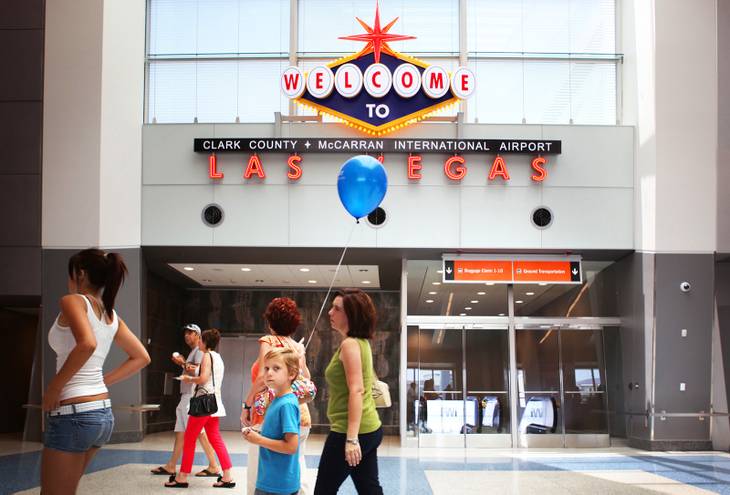International travel to the United States has doubled in the past 20 years and few places have seen a greater expansion than Las Vegas, the Brookings Institution’s Metropolitan Policy Program said in a report issued today.
The 28-page “Global Gateways: International Aviation in Metropolitan America” report, authored by Adie Tomer, Robert Puentes and Zachary Neal, is the first study to track the flow of passengers among multiple U.S. metro areas and international destinations.
The report ranks the 100 largest metro areas by the number of passengers through their airports, the most popular international destinations through those airports and the most trafficked corridors between U.S. and international locations.
Past traffic flow research has been dependent on U.S. Commerce Department data that focused primarily on key gateway cities such as Los Angeles, San Francisco and New York.
The Commerce Department data tracked foreign passengers to those gateway cities, but not to other cities beyond the arrival point. In previous years, the city’s tourism marketers knew that thousands of international visitors were coming to Las Vegas, but landed in other cities first and they had to approximate how many came from specific cities.
The Brookings study says 54.7 percent of its international visitors arrive in Las Vegas on nonstop flights.
According to the report, Las Vegas’ McCarran International Airport had 4.6 million international passengers in 2011, a 92.4 percent increase since 2003, the third largest by percentage increase.
The two cities with higher percentage increases had smaller baseline numbers — New Haven, Conn., a 133.5 percent increase to 3,841 passengers, and Akron, Ohio, a 131.7 percent increase to 57,279.
The 4.6 million passengers in 2011 was the ninth highest total in the United States.
Other large fast-growing airports included those in Charlotte, N.C., an international hub for US Airways, and Las Vegas tourism rival Orlando.
Over the same eight years, passenger traffic has grown 66.4 percent in Charlotte and 60.1 percent in Orlando.
Not surprisingly, the largest number of foreign visitors to Las Vegas come from North America since the city’s dominant foreign tourism markets are Canada and Mexico. Visitation from North American cities has more than doubled since 2003.
Visitation also has more than doubled from developing Asian countries such as India and the Philippines, Eastern Europe/Central Asia and sub-Saharan Africa. Visitation has more than tripled from the Middle East and Northern Africa.
A more prominent Las Vegas visitor source — Western Europe, the city’s second largest international market — is up 81.7 percent since 2003. The developed Asian Pacific region provided the weakest increase at 29.3 percent.
The Brookings study broke down the top 200 cities from which tourists come to Las Vegas. The biggest international provider of visitors to the city: Toronto, with an estimated 470,378 visitors last year, a 110.7 percent increase since 2003.
The rest of the top 10 are London; Calgary, Alberta; Vancouver, British Columbia; Mexico City; Edmonton, Alberta; Montreal; Manchester, United Kingdom; Guadalajara, Jalisco; and Frankfurt, Germany.
The report also listed the top 50 route corridors into the United States. Toronto-Las Vegas ranked No. 26 on the list and London-Las Vegas was No. 31. The top three routes are London-New York, Tokyo-Honolulu and Toronto-New York.
Other details from the report:
• Of the 200 cities from which tourists visit Las Vegas, only a handful had fewer arrivals last year than in 2003. Among them: Tokyo, Hong Kong, Taipei and Singapore. Las Vegas once had nonstop flights from Tokyo on Northwest and Japan airlines and from Hong Kong on Singapore Airlines, which once flew a route from Singapore to Hong Kong to Las Vegas.
• Korean Air’s nonstop route from Seoul to Las Vegas is responsible for one of the biggest increases in international tourism. Currently the No. 12 market for the city, Seoul delivered 9,971 tourists in 2003 and 78,414 last year, a 686.4 percent increase.
• The Las Vegas Convention and Visitors Authority has had its eye on Brazil as an emerging market. The Brookings report says Sao Paulo is Las Vegas’ No. 14 market with a 456.8 percent increase in tourists since 2003 despite having no direct Las Vegas flights. The city’s marketers are optimistic that recently added one-stop service from South America on Panama-based Copa Airlines will pay dividends in the future. Copa will make what once was three-times-a-week service to daily flights in December.
• How’s this for a major percentage increase? Mahe, Seychelles is listed by Brookings as Las Vegas’ No. 172 market with 1,413 visitors in 2011. That’s a 28,160 percent increase from the five visitors who arrived in 2003.
• The report also notes that while airports in the 100 largest metro areas handle 96 percent of all international passengers, they receive just 36 percent of federal funds for maintenance and improvements to airport infrastructure.
The LVCVA and officials at McCarran have long recognized the importance international tourism has on the city because visitors tend to stay longer and spend more than their domestic counterparts.
LVCVA President Rossi Ralenkotter has a goal of increasing the percentage of Las Vegas tourists from the current 16 percent to 30 percent by 2020.
The mission to increase international travel got a boost last summer when McCarran opened its $2.4 billion Terminal 3.
Sixteen foreign air carriers offer 188 flights a week to and from 21 international destinations at McCarran. Four of those weekly flights will end in December when Philippine Airlines ends its one-stop service from Manila, and some carriers have discontinued seasonal service until next year.
